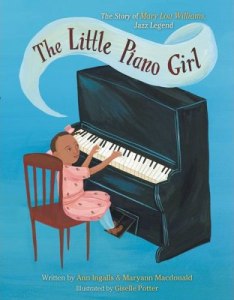Recently, I heard about a picture book called The Little Piano Girl, all about jazz legend Mary Lou Williams‘ musical childhood. While I’m waiting for the opportunity to pick up the book, I thought it would be a good idea to read up about Williams’ career and make a History Hunt post about her. She may be better-known than many of the artists and composers I’ve featured on this blog, but that doesn’t mean she’s not worthy of a post–especially since her birthday is coming up!
Mary Lou Williams was born Mary Elfrieda Scruggs on May 8, 1910. She was surrounded by music from the very start of her life–when she was only a toddler, her mother would keep her on her lap as she practiced the pump organ. And Williams was paying attention! In her own words:
One day, when she was pumping the organ, my fingers beat her to the keyboard and began playing. And it must have been great, because she ran out and got the neighbors to listen to it.
(Source: Mary Lou Williams: A Centennial Celebration)
After that, Williams’ mother taught her spirituals, ragtime, and boogie-woogie. Williams learned so quickly that she was playing professionally by the time she was six or seven and was known as “The Little Piano Girl of East Liberty.”

The Little Piano Girl: The Story of Mary Lou Williams, Jazz Legend, by Ann Ingalls and Maryann Macdonald. Illustrated by Giselle Potter.
After touring throughout her teenaged years, Williams married and joined the same band as her husband. The band was called Twelve Clouds of Joy. At first, her fellow band members didn’t realise what an incredible musician they had: for a year, she was only their substitute pianist. But when their other pianist left, Williams became Twelve Clouds of Joy’s full-time pianist, and it was her performances, arrangements, and compositions that made the band famous.
Even if it took a while for Twelve Clouds of Joy to appreciate Williams’ genius, some of the greatest jazz musicians of the day were lining up at her door to have her write and arrange for them. Her fans included Louis Armstrong (whom she met at age fifteen), Duke Ellington, Benny Goodman, and Thelonius Monk, among others.
Like Mamie Smith and Sister Rosetta Tharpe, Mary Lou Williams left the United States to tour Europe. She was so successful, she lived there for two years. But then, one day in 1954, Williams walked out in the middle of one of her performances, exhausted both physically and mentally. She went on a hiatus from performing for three years to get her strength back.
In this time, Williams returned to the United States and converted to Roman Catholicism. For a while after that, she didn’t perform much at all. She wasn’t sure how jazz, which still was looked at with suspicion by the church, fit into her faith. Finally, three of her friends–two priests and Dizzy Gillespie–persuaded her to take up music again. After that, she wrote both religious and non-religious music alike. She even wrote jazz masses! One of them, Mary Lou’s Mass, was performed in St. Patrick’s Cathedral in New York City–the first time jazz was ever performed in that church.
Not only was Williams a brilliant musician, she was also a compassionate human being. She started the Bel Canto Foundation to help musicians who were trying to leave behind drug addictions return to their careers. She made the Mary Lou Williams Foundation, to help young people learn about jazz, and she set up two thrift stores where the proceeds (and ten percent of her own income) would go to musicians in need.
Later in life, Williams recorded The History of Jazz, for which she played the piano. She became an Artist-In-Residence at Duke University in Durham, North Carolina, taught jazz history, ran the university’s jazz ensemble, gave interviews, appeared on both Sesame Street and Mister Rogers’ Neighbourhood, and, of course, kept performing–including at the White House!
Williams has been honoured in numerous ways in recent times. The Mary Lou Williams Women in Jazz Festival is held every year in Washington, DC and Duke University now hosts the Mary Lou Williams Center for Black Culture. And, of course, there’s The Little Piano Girl!
To hear one of Williams’ compositions, try “My Mama Pinned a Rose On Me,” which you can listen to below:
If you’re enjoying the History Hunt series, why not drop me a tip or subscribe to me at Patreon? History Hunt will always be free–this is just an option for my readers to show their appreciation.
To Learn More (sources):
Mary Lou Williams: A Centennial Celebration at NPR.org
Mary Lou Williams at the Mary Lou Williams Center for Black Culture
Mary Lou Williams at PBS.org
Mary Lou Williams at Biography.com
Williams, Mary Lou [née Scruggs, Mary Elfrieda; Burley, Mary Lou] at Oxford Music Online
Mary Lou Williams On Piano Jazz at NPR.org
Mary Lou Williams at All About Jazz
Mary Lou Williams at Muppet Wiki
Mary Lou Williams at Wikipedia.org